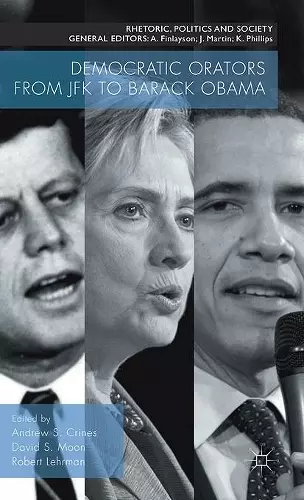Democratic Orators from JFK to Barack Obama
Andrew S Crines editor David S Moon editor Robert Lehrman editor
Format:Hardback
Publisher:Palgrave Macmillan
Published:6th Jan '16
Currently unavailable, and unfortunately no date known when it will be back

Once a celebrated art, oratory is now more likely to be discussed as a lost or declining one. Yet as this volume demonstrates, oratorical skill remains a powerful tool for any politician. This illuminating collection examining orators in the Democratic Party will be a must read for students and scholars of politics and communication.' - Richard Hayton, University of Leeds, UK 'A powerful and impressive contribution to our understanding of the interlocking themes of oratory, rhetoric and leadership in the United States. Its authors combine detailed knowledge of the changing context of political speech making with a sensitive appreciation of the conceptual framework used in the study of communication. It will be an essential book not just for students of American politics but for anyone interested in the art of democratic persuasion.' - Gillian Peele, University of Oxford, UK 'This volume is not dazzled by the mythology surrounding oratory in the Democratic party. Instead, the authors conduct rigorous examination of the rhetoric of key political figures. Conceptual tools are accessibly applied to provide rich and engaging accounts of how oratory and rhetoric have been used to powerful political effect.' - Stuart McAnulla, University of Leeds, UK
How do leading Democratic Party figures strive to communicate with and influence their audience? More broadly it evaluates the impact of leading orators upon American politics and argues that effective oratory remains a vital party of American political discourse.
How do leading Democratic Party figures strive to communicate with and influence their audience? Why have some proven more successful than others in advancing their ideological arguments? How do orators seek to connect with different audiences in different settings such as the Senate, conventions and through the media? This thoroughly researched and highly readable collection comprehensively evaluates these questions as well as providing an extensive interrogation of the political and intellectual significance of oratory and rhetoric in the Democratic Party. Using the Aristotelian modes of persuasion ethos, pathos and logos it draws out commonalties and differences in how the rhetoric of Democratic Party politics has shifted since the 1960s. More broadly it evaluates the impact of leading orators upon American politics and argues that effective oratory remains a vital party of American political discourse.
Once a celebrated art, oratory is now more likely to be discussed as a lost or declining one. Yet as this volume demonstrates, oratorical skill remains a powerful tool for any politician. This illuminating collection examining orators in the Democratic Party will be a must read for students and scholars of politics and communication.' - Richard Hayton, University of Leeds, UK
'A powerful and impressive contribution to our understanding of the interlocking themes of oratory, rhetoric and leadership in the United States. Its authors combine detailed knowledge of the changing context of political speech making with a sensitive appreciation of the conceptual framework used in the study of communication. It will be an essential book not just for students of American politics but for anyone interested in the art of democratic persuasion.' - Gillian Peele, University of Oxford, UK
'This volume is not dazzled by the mythology surrounding oratory in the Democratic party. Instead, the authors conduct rigorous examination of the rhetoric of key political figures. Conceptual tools are accessibly applied to provide rich and engaging accounts of how oratory and rhetoric have been used to powerful political effect.' - Stuart McAnulla, University of Leeds, UK
ISBN: 9781137509024
Dimensions: unknown
Weight: 5121g
313 pages
1st ed. 2016